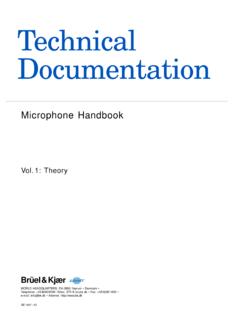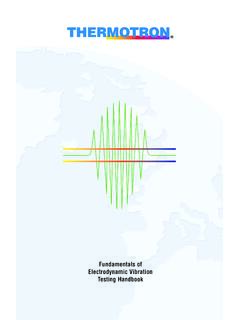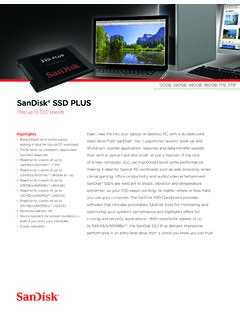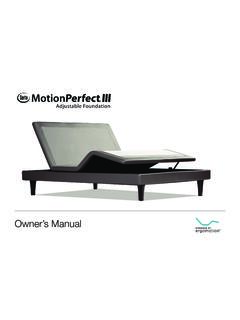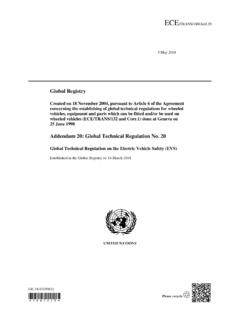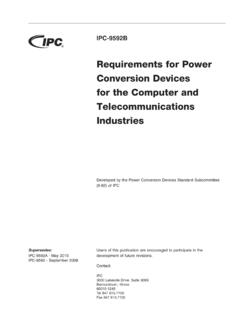Transcription of Vibration Testing (br0227) - Brüel & Kjær
1 ~ Bruel & Kj r Introduction See paQe This booklet gives an introduction to the methods used Introduction 1. in Vibration Testing and a description GI tne Vibration Why Vibration lesting? 2. exciters and control equipment used in environmental How does an exclter work? 3. 1estlng and in determlna,tlmll of dynamic proper\Jies of The power amplifier 4. structures. The exciter control 4. Basic exciter Instrumentation 5. ,S ine excitation 5. Random excitation 6. Environmental teating 7. Mounting of the teat object 7. Fixtures 8. Static compensation 9. Vibration ,r eaponae li nveatigation 10. Endura,nce conditioning 11. Swept sine Testing 11. Conditioning at aingle frequencies 12. Random teating 13. Derivation of teat data 14. Structural, rHearch 15. Mecl1anlcal impedance and mobility 16. AddJtion of impedances and moblllties 17.
2 Complex elastic modulus 18. Mode studies 19. Resonance studlea 20. 0'. Use complex plots Excitation methods 21. 22. Multi-shaker syatfitfl1s 23. 1983. Why Vibration Testing ? Due to the demands of high speed operation and the use Environmental Testing of light structures In modern machinery, static measure- ments of stress/strain properties are not sufficient. Dy- Calibration namic measurements are necessary and Vibration 't est- ing has therefore found widespread use. In the environmental laboratory, Vibration Testing is per . formed as part of a company's quality assurance pro- gramme together with for example temperature and hu- midity tests to ensure product reliability. The test object is exposed to a certain Vibration level according to a procedure specified by national and Internatrionai standards, To find the dynamic properties of a structure, the re- sponse to a vibrational force Is of interest rather than the actual Vibration level.
3 This concept is found for instance in determination of the ability to transmit or damp vibra- tions or In the description of the vibrational modes of a structure at resonances. In the calibration of Vibration transducers a comparison is made between the transducer to be calibrated and a reference transducer at a prescribed Vibration level. To produce a defined Vibration an electromagnetic vi- bration exciter (also called a shaker) Is used. This con- verts an electric signal Into a mechanical movement, controlled to maintain a certain Vibration level or force. 2. t How Does an Exciter Work? In principle the electromagnetic Vibration exciter oper- F/ Exciter table ates like a loudspeaker, where the movement is pro- duced by a current passing through a coli in a magnetic field. The force used to accelerate the moving element is Flexure proportional to the drive current and the magnetic flux.
4 Therefore by controlling the current, the Vibration level of the exciter can be controlled. In small exciters the magnetic field is produced by a permanent magnet, whereas in the larger ones electro- magnets are necessary. The maximum current and the Drivecoil I. load determines the acceleration level which can be ob- tained. At low frequencies, however, this acceleration F=BIL F = force IN]. level will decrease due to displacement limitations of the B = flux intensity IT}. moving element. Resonances in the moving element will I = current lA]. set the upper frequency limit. L = length Im]. F=ma m = mass {kg]. The performance of an exciter is presented in a diagram, a = acceleration Im/s2]. the maximum acceleration as a function of fre- quency. With double logarithmic scales the displacement limit will be represented by a straight line with a slope of 12 dB/octave.
5 A velocity limit is often also found, espe- cially with the larger exciters, and this is Indicated by a line with a slope of 6 dB/octave. ri fflO "tl .. E: m, s CS m2..!!QI..~. (.) ffla (.). cs ~ log frequency fI20501. 3. The Power Amplifier The frequency response for an exciter driven by a con- stant current will show three regions of different na- ture. The first two regions represent the spring-mass system of the moving element and Its suspension with a resonance of typically 20 Hz. In the third region, typi- Constant Current cally above 5 kHz for big exciters, axial resonances in I. the moving element will occur, set1lng the upper opera- tional frequency of the exciter. I. , controlled .0--__. ' MQ88. eontroUed A response curve for an exciter with a constant voltage input will show the same regions of control, but the lower resonance is considerably damped, giving an easier control of the level.
6 The voltage control, obtained by it low Impedance amplifier is normally preferred. In some cases, however, a current control will be advantageous, requeney_. primarily when the exciter is used as a force generator or where non-feedback control is required using the mid frequency range of the e)(citer. This demands a high impedance output and therefore amplifiers will often have selectable impedance outputs. Exciter The EXCiter Control The use of a Vibration exciter assumes a constant vibra- tion level at the table. The frequency response curve is not flat. it contains resonances, and other resonances will be introduced when a test object Is mounted on the Amplifier exciter. When used throughout a frequency range the gain of the amplifier must consequently vary with fre- quency. This gain is set by a controller, receiving feed- back information from the test object.
7 The main ele- Resulting ments of an exciter control must therefore be a frequen- acceleration cy generator, a Vibration meter and a level contrOlling -4 circuit. ~- ----- .. Basic Exciter Instrumentation A basic set-up consists of an exciter, a power amplifier, an exciter control , an accelerometer or force transducer and a conditioning amplifier. ,, ,..--------' -----. ~ . , The exciter is selected primarily according to the force or acceleration requ ired, but other parameters may be i ',r"----, I. important such as Its abiUty to take up side loads, the I. I. transverse Vibration and the distortion of the waveform. : tL-_ _---'. I. The exciter Is Isolated from its base by springs, in most I. I. cases giving sufficient protection from environmental I. I. Vibration when bolted directly on the floor. However, to I. reduce the Vibration transmitted to the building by excit- I.
8 I. ers used for high level applications, the exciter must be mounted on resilient material or a seismic block. Sine Excitation Sine signals, swept or at a single frequency, are by far the most commonly used excitation Inputs: the control is relatively simple, a large amount of reference material exists, and the response Signals are easy to measure. When the signals are swept, a feedback control, known as a compressor Is applied. The demand to the com- pressor is that it shOUld be fast enough to react to low damped resonances even at high sweep rates. A dynam- ic range of at least 80 dB and compressor rates up to 1000 dB/sec are normally found. Specified level Sine signals are described by their frequency and ampli- tude. In Vibration Testing the amplitude is normally In Ji'requenC)l terms of peak values (displacement 8S peak-peak) with frequencies ranging between 2 and 10,000 Hz.
9 5. _____ _ . - - _ __ ~~. Random Excitation A random signal used in Vibration Testing has a continu- P_k = {2 Peak --=3. ous spectrum, with amplitudes varying according to a RMS RMS. Gaussian distribUtion. Within the specified frequency range any ampJlludes should be present, but in practice the generators and amplifiers will give limitations. In Vibration Testing It is generally demanded that a random Signal should contain peak-values of three times the RMS value. The force produced by an exciter is mainly limited by the heating effect of the current. the RMS value. whereas the power amplifier rating is influenced by the peak Amplimck Di8tri~on (or Random Signals values. To give the same force the amplifier must there- fore be larger when used with random than with sine excitation. The random spectrum is described by its power spec- tral density or acceleration spectral density.)}
10 ASD. m/s2)2/HZJ. To shape and control this. the Vibration I(1bl <:JI() ~100 l(}(}--:JI()OO >:1000. must be analyzed by a narrow band analyzer and com- pressor loops applied to ea9h bandwidth. Digital tech- niques based on Fourler transforms are normally used ~ (7)iru 0 ( 1'00 ye. 0. 0. and the control is achieved using a computer, a pro- ASIJ. cess called equalization. ((~rlH~l test spectrum The random capacity of an exciter is specified as the ------------ tJcoording to maximum acceleration spectral density at different ISO 5344. loads of a spectrum, shaped according to the Interna- 6. lional Standard, ISO 5344. f 20 100 2000..- freqlUncy. Hz_7. Environmentall Testilng An environmental test Is performed to determine the ability of equipment to withstand specified severltles of Vibration , shock, temperature, humidity, etc.)))))





